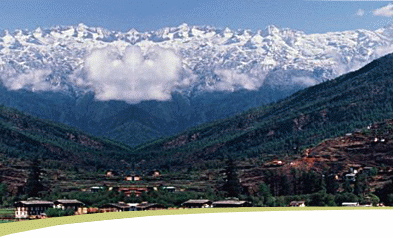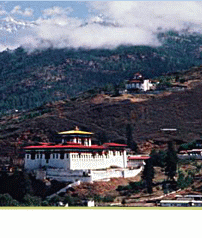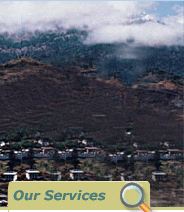| PARO
VALLEY
Generally visitors enter the Kingdom at Paro by the
National Airline, Druk Air. This beautiful valley, if
ever a place exists, here nature and man consulted to
create their dearest image, it must be the valley of
Paro. Mt. Chomolhari 7320m reigns in white glory at
the northern end of the valley and its glacial waters
plunge through deep gorges to form the Pa-chu (Paro
River). Paro is one of the most fertile valleys in the
kingdom producing a bulk of the famous red rice from
its terraced fields home to some of Bhutan’s oldest
temples & monasteries.
Drugyal Dzong: which means victorious
fortress was built in 1647 by Shabdrung Ngawang Namgyel
to commemorate his victory over the Tibetan invaders,
led by Mingolian warlord, Gushri Khan in 1644. Strategically
built over the only passage into Paro valley, the dzong
helped to repel numerous invasions all through the course
of Bhutanese history. It so impressed early visitors
that in 1914 the dzong featured on the cover of the
National Geographic magazine. The dzong was gutted by
an accidental fire in 1951. The ruins, as still attract
tourists.
Taktsang Monastery: literally means
the Tiger’s den. This temple clings precariously
to a granite cliff 800m above the Paro valley. Legend
has it that the great Guru Padmasambhava flew to this
spot on back of a tigress and meditated in a cave during
the 8th century. The temple was built around the cave
and is a hallowed shrine for Bhutanese Pilgrims. A terrible
fire in April 1998 destroyed Taktsang’s medieval
wall paintings and all inner temples. A new construction
has already begun by the royal Government.
Rinpung Dzong: meaning the fortress
on a heap of Jewels was built during the time of Shabdrung
in 1946. The approach to the dzong is through a traditional
covered bridge. A walk to the dzong offers a good view
of the architectural wonder of the dzong as well as
life around it. The dzong now houses the Paro monastic
school and the office of the civil administration. It
is also the venue of the great Paro Tshechu (festival)
held once a year in spring.
Ta Dzong: looking down upon the Rinpung
dzong was built in 1651 as a watch tower. The Ta Dzong
is round more like parts of a European castle. Since
1967 the dzong was re-established as the national museum
and holds fascinating collections of arts, relics and
religious thankha paintings.
Farm House: the beauty of Paro valley
is embellished by cluster of quaint farm houses. Bhutanese
houses are very colourful and traditionally built without
the use of a signal nail. The house looks very big from
outside but is quite simple inside. Its normally three
storeys. The ground floor is always used for cattle
while the attic is used to store hay. The families live
in the middle floor. The best room is always kept for
the family chapel. A visit to a farm house is very interesting
and offers a good glimpse into the lifestyle of a farmer.
|






